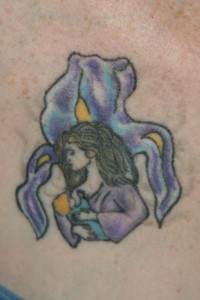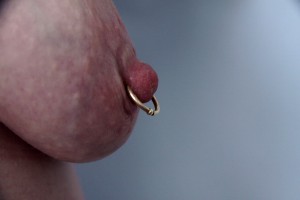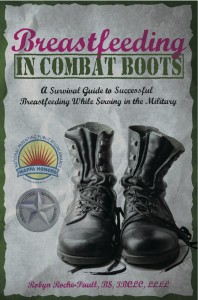 “You can’t breastfeed if you have tattoos on your breasts, the ink will get into your breastmilk.”
“You can’t breastfeed if you have tattoos on your breasts, the ink will get into your breastmilk.”
“You’ll never be able to breastfeed since your nipples have been pierced.”
“Your baby will get HIV or Hepatitis from your body mods if you breastfeed.”
These are just some of the things said to women who have body mods and want to breastfeed. Oftentimes they hear these myths from health care practitioners, other times it is from well-meaning friends or uninformed breastfeeding support counselors. Contrary to popular belief, body mods and breastfeeding are compatible, so long as certain precautions are followed.
Now infants can get
all their vitamin D
from their mothers’ milk;
no drops needed with
our sponsor's
TheraNatal Lactation Complete
by THERALOGIX. Use PRC code “KELLY” for a special discount!
A Brief History of Body Mods
Body Modifications are a group of practices that include branding, scarification, tattooing, piercing, and other types of body art. Archaeologists, historians and body art practitioners note that tattooing and body piercing have been performed, in one form or another, worldwide for over 5000 years. Recently however, body modifications have experienced an explosion in popularity, with people both young and old getting body mods of various types. More than 20 million Americans, more than half of whom are women, have one or more tattoos and up to 30% have piercings, and nearly 10% have both (DeBoer, Seaver, Angel, & Armstrong, 2008). This surge in body modifications shows no signs of slowing down in the near future.
Many women today get tattoos and piercings as a form of self-expression or to commemorate a special occasion or life event (Caliendo, Armstrong, & Roberts, 2005). For whatever reason, women today are getting body modifications in greater numbers at the same time that many are also becoming mothers. Along with the rise in body modifications, breastfeeding has seen resurgence in popularity as well. With breastfeeding rates climbing it is not surprising that many new mothers, who either already have body modifications or who may be contemplating them in the future, might have questions as to the safety of breastfeeding. Is breastfeeding safe with current tattoos and nipple piercings? Can you get a new tattoo or piercing while breastfeeding? This article will help you answer those questions and dispel a few myths along the way.
Nipple piercings
 Nipple piercings are a favorite among body mod fans, but they require patience when healing and are not without risk. Nipple piercings can take up to a full year to heal completely, with infections and rejections due to improper aftercare the most common problems. If you are contemplating getting your nipples pierced and also want to have a baby, it is best to plan to get your piercings at least 12-18 months before you plan to get pregnant (Angel, 2009). This allows the piercing time to heal and create a fistula, or channel, before the bodily and hormonal changes that accompany pregnancy occur. It also will allow for removal of the jewelry during breastfeeding without the worry of the channel closing up. The nipple(s) must have time to heal and cannot have any saliva enter the open wound; the jewelry must also remain in place during the healing period, something that is next to impossible to achieve with a young baby to feed frequently. If you have just recently had a baby, be aware that professional piercers will not pierce a woman who is currently breastfeeding and will actively discourage a new mother from doing so. In that case you will have to decide if you can wait until your baby weans. Another option to consider is drying up one breast and piercing your nipples one at a time.
Nipple piercings are a favorite among body mod fans, but they require patience when healing and are not without risk. Nipple piercings can take up to a full year to heal completely, with infections and rejections due to improper aftercare the most common problems. If you are contemplating getting your nipples pierced and also want to have a baby, it is best to plan to get your piercings at least 12-18 months before you plan to get pregnant (Angel, 2009). This allows the piercing time to heal and create a fistula, or channel, before the bodily and hormonal changes that accompany pregnancy occur. It also will allow for removal of the jewelry during breastfeeding without the worry of the channel closing up. The nipple(s) must have time to heal and cannot have any saliva enter the open wound; the jewelry must also remain in place during the healing period, something that is next to impossible to achieve with a young baby to feed frequently. If you have just recently had a baby, be aware that professional piercers will not pierce a woman who is currently breastfeeding and will actively discourage a new mother from doing so. In that case you will have to decide if you can wait until your baby weans. Another option to consider is drying up one breast and piercing your nipples one at a time.
Many women who already have nipple piercings are concerned about their ability to breastfeed. Breastfeeding is not generally affected by established nipple piercings. Human nipples have between 8-12 nipple pores therefore it is unlikely that a well-healed piercing will block all of the pores. However, there have been a few reported cases of abnormal milk production in women with nipple piercings due to possible duct obstruction (Garbin, Deacon, Rowan, Hartmann, & Geddes, 2009). More often women find that when they do remove their jewelry for a feeding that milk leaks out the piercing, this can be problematic if the flow is too fast for your infant. In either case, be proactive about preventing or reducing any engorgement and be on the lookout for blocked ducts or mastitis, all of which may be exacerbated by nipple piercings (Armstrong, Caliendo, & Roberts, 2006).
It is best to remove your jewelry for each feeding, to reduce the risk of your baby aspirating or choking, although some women do nurse with flexible PTFE barbells in place (Angel, 2009). Removing your jewelry also reduces the risk of latching-on problems, such as damage to the inside of your baby’s mouth or the passing of bacteria from the jewelry to your baby. If you chose to keep your jewelry out permanently until your baby is weaned, be aware that even a fully healed piercing may close and some women have noticed nipple pain in a previously pierced nipple while nursing (Wilson-Clay & Hoover, 2005). You can keep the piercing open by inserting an insertion taper on a regular basis. If the channel closes completely wait at least three months post-weaning before re-piercing (Armstrong, Caliendo, & Roberts, 2006). If you face any problems with breastfeeding be sure to contact your local LLL Leader or an IBCLC for help. For problems with your piercing you should be seen by a qualified piercer.
Tattoos
Tattoos are a permanent form of artwork etched into the flesh and are also not without risk. As with piercings, local and systemic infections due to improper aftercare are the most prevalent risks of tattooing, an allergic response to the inks used in the tattoo is another possibility. Already present tattoos, on the breast or elsewhere, do not impact breastfeeding. Tattoo inks are made of synthetic or natural pigments (some are made with heavy metals) and the FDA does NOT regulate them as they are not meant to be injected under the skin (FDA, 2012). Tattoos are permanent because the ink remains walled off within the body via the body’s inflammatory process, making the possibility of the ink migrating into the mother’s blood plasma and then into the milk-making cells of the breast, next to impossible.
Like piercers, professional tattoo artists will not knowingly tattoo a woman who is currently breastfeeding and will actively discourage a new mother from doing so. Tattoo artists feel that the body needs time to heal the tattoo and that it is harder to do so when the body is producing milk. Not tattooing a breastfeeding mother also lessens the possibility of any infections, from either improper tattooing or aftercare, from being passed on to the baby (Hudson, 2009). If you choose to get a tattoo while breastfeeding keep in mind that a newborn baby is far more vulnerable to any possible changes in breastmilk than a nursing toddler. It is best to wait until your baby is at least 9-12 months old. Going to a professional tattoo shop following Universal Precautions also lessens the risk of any infections that might be acquired.
Tattoo Removal
It is estimated that 20% of those who get tattoos later regret the decision and wish to have them removed (Armstrong, et al., 2008). Tattoo removal is now accomplished with the use of Q-switched lasers. The laser works by producing short pulses of intense light that passes through the skin to be absorbed by the tattoo pigment. The laser energy causes the tattoo pigment to fragment into smaller particles, which are picked up by the body’s immune system and filtered out. The particles are considered too big to pass into breastmilk. The removal process is bloodless, low risk and has minimal side effects (Reardon, 2008). The same aftercare as for a tattoo applies to its removal. Tylenol is often prescribed for the pain, if needed. Possible side effects include pigmentation changes, local infection (due to not following the aftercare regimen) and possible allergic reaction to the ink that is now ‘free’ in the mother’s system. Mothers usually have no problems if they follow the recommended aftercare procedures.
Universal Precautions
Whether you are contemplating a tattoo or getting your nipples pierced it is very important that your tattoo artist or piercer follow Universal Precautions. Professional tattooists and piercers will follow all universal precautions such as sterilization of the tattoo machine and piercing implements using an autoclave, single-use inks, ink cups, gloves and needles, bagging of equipment to avoid cross contamination, thorough hand washing with disinfectant soap and the wearing of gloves when performing the tattoo or piercing (Armstrong, et al., 2006). Any jewelry that is to be inserted should be kept sterile before insertion as well. There have been no known cases of HIV passed on through tattoos or piercings via regulated artists that follow Universal Precautions. It is important to screen your piercer/tattooist and the shop carefully, checking with the local health department for local laws and regulations. Reputable body artists support regulations and legislation to keep their customers safe and to legitimize the profession. The Association of Professional Piercers and the Association of Professional Tattooists both have a wealth of information on safe body modifications and what to look for in a practitioner. Finally, keep in mind that human milk cannot be donated to a milk bank if the mother has received a piercing or tattoo within the previous 12 months due to possible infectious disease transmission (HMBANA, 2003).
If you are a mother who has or desires body modifications, you should feel safe knowing that you can still successfully breastfeed if you follow the precautions outlined above. Go ahead and make a statement with your piercings and tattoos, just follow the rules and make sure your piercer or tattoo artist does too. Body art and breastfeeding are not mutually exclusive. You can certainly provide your baby with his mother’s milk from a very beautifully decorated and adorned body.
Handout (for personal use only): What Every Breastfeeding Mother Needs to Know About Body Modifications
References
Angel, E. (2009). The piercing bible : the definitive guide to safe body piercing. Berkeley, Calif.: Celestial Arts.
Armstrong, M., Caliendo, C., & Roberts, A. (2006). Pregnancy, lactation and nipple piercings. AWHONN Lifelines, 10(3), 212-217.
DeBoer, S., Seaver, M., Angel, E., & Armstrong, M. (2008). Puncturing myths about body piercing and tattooing. Nursing, 38(11), 50-54.
FDA, (2012). Tattooing & Permanent Makeup Retrieved May 17, 2017, from http://www.fda.gov/Cosmetics/ProductandIngredientSafety/ProductInformation/ucm108530.htm
HMBANA, (2011). Guidelines for Establishment and Operation of a Donor Human Milk Bank. Raleigh, NC: Human Milk Banking Association of North America, Inc.
Hudson, K. L. (2009). Living canvas : your total guide to tattoos, piercing, and body modification. Berkeley, CA: Seal Press : Distributed by Publishers Group West.
Reardon, J. (2008). The Complete Idiot’s Guide to Getting a Tattoo. New York: Penguin.
Wilson-Clay, B., & Hoover, K. (2005). The breastfeeding atlas (3rd ed.). Manchaca, Tex.: LactNews Press.
Internet
BMEzine (contains graphic and explicit images)
http://www.bmezine.com
Alliance of Professional Tattooists, Inc.
(407) 831-5549
http://www.safe-tattoos.com
The Association of Professional Piercers
PO Box 1287
Lawrence, KS 66044
(888) 888-1277
http://www.safepiercing.org

